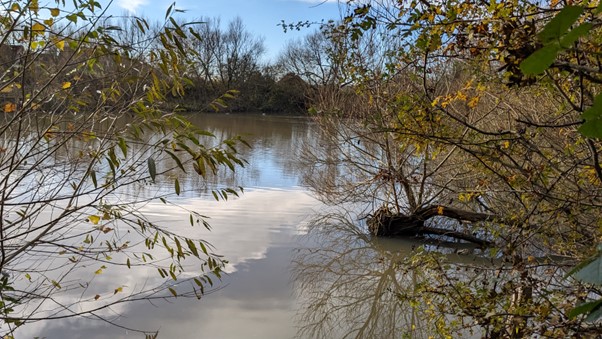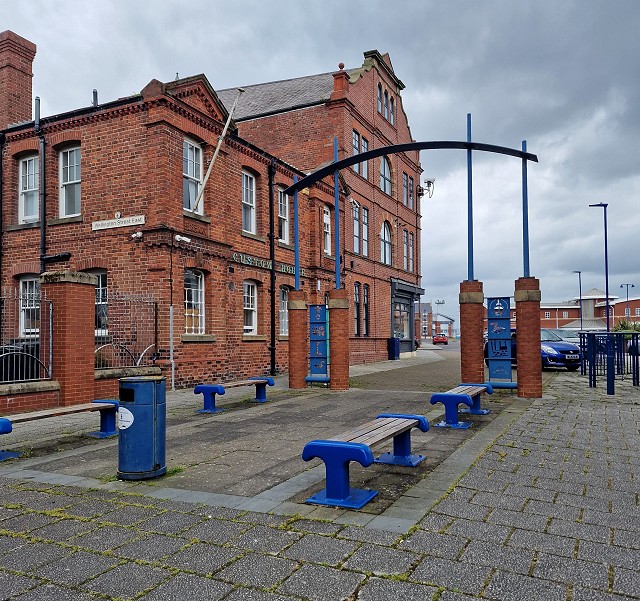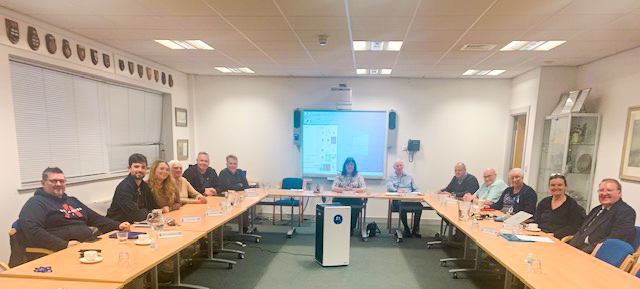
Neighbourhood Plan
Blyth Neighbourhood Plan Pre-Submission Draft
13/11/2024
Blyth Town Council is inviting comments on a draft neighbourhood plan for the town.
Neighbourhood plans enable the local community to guide where and how future development happens. They are prepared by Town and Parish Councils, rather than Northumberland County Council. They must be supported by the local community and once adopted, the policies within them are used to assess planning applications against.
Work started on the Blyth Neighbourhood Plan in 2022, and the Town Council has had a number of engagement events which have shaped the draft neighbourhood plan.
The draft plan contains seven policies covering a wide variety of topics, such as the town centre, supporting retail development and protecting our conservation areas. A major part of the plan are policies to protect our valued green spaces and heritage assets. The plan also has a number of community actions regarding specific projects to improve the area, such as input to projects to upgrade the existing rights of way network.
Jo-Anne Garrick, Planning Consultant said: “Neighbourhood Plans are important, formal planning documents that contain planning policies created in consultation with a neighbourhood area. They supplement the planning policies of a local planning authority, Northumberland Council. This is an opportunity for Blyth to have a greater say in how the community is developed in future”.
This is the last chance for residents, businesses, and stakeholders to provide their input before the plan is submitted to Northumberland County Council for an independent examination.
The consultation period commenced on Wednesday, 13 November 2024, and will conclude on Monday, 6 January 2025 – although we are only legally required to consult for six weeks we are extending this due to the Christmas period.
Councillor Aileen Barrass, Mayor of Blyth added, “I encourage all residents, businesses, and stakeholders to actively engage in this final consultation on our draft Neighbourhood Plan. This is your last opportunity to contribute before we submit it to Northumberland County Council. It’s your chance to comment on the future of our town—shaping the direction of development, preserving our heritage, and ensuring Blyth grows in a way that benefits everyone. Your feedback is invaluable as we work together to create a plan that reflects the needs and aspirations of our community. Please take the time to share your thoughts, so we can build a stronger, more vibrant Blyth for future generations."
To find out more and access the consultation documents visit Neighbourhood Plan Consultation
Consultation Update on Green Spaces and Heritage Assets
28/05/2024
Between December 2023 and February 2024, a consultation took place regarding proposed open spaces for protection, and the identification of non-designated heritage assets within the Blyth Neighbourhood Plan. During this period, two background papers and summary information were accessible online, and hard copies of the documents were available for viewing at various locations, including Blyth Library, Project Space in the Keel Row, Isabella Community Centre, Briardale House, and Buffalo Community Centre.
The consultation received 24 responses related to the proposed green spaces and 18 responses concerning the proposed non-designated heritage assets.
Remember, community participation plays a crucial role in safeguarding our environment and cultural heritage. Let’s continue working together to ensure a sustainable and vibrant future for Blyth!
Enhancing Urban Quality: The Role of Local Green Spaces
In our neighbourhood plan, we have the opportunity to safeguard certain areas in Blyth from inappropriate development by designating them as local green spaces. To achieve this, these spaces must meet nationally defined criteria and hold special significance for the local community. Such significance can stem from a range of factors, including their beauty, historical value, recreational opportunities, tranquillity, or the richness of their wildlife.
It is important to note that local green space designation is akin to the concept of the Green Belt. Therefore, any proposed allocations must be backed by robust evidence demonstrating how they align with the defined criteria.
Additionally, our plan allows for the identification of protected open spaces. While these areas may not fully meet the detailed local green space criteria, they still hold importance due to their amenity value or suitability for formal and informal recreation.
Through thorough assessment, we have identified 31 sites proposed for local green space designation and six sites proposed for protected open space. Encouragingly, all residents who participated in the process supported the allocation of these proposed local green spaces. Among the most popular spaces are:
- Ridley Park,
- Newsham Pond,
- Meggies Burn,
- Croft Park,
- Broadway Field,
- Blyth Links and Beach Gardens,
- Isabella Heap,
- Isabella Field,
- South of River Blyth,
- east of Halfpenny Woods, and
- South Newsham Pavilion.
Furthermore, helpful comments have been provided, which will strengthen the justification for these allocations. Additionally, some residents suggested additional sites for inclusion, many of which are already protected through the Northumberland Local Plan.

Understanding Non-Designated Heritage Assets in Planning
Heritage assets come in two categories: designated and non-designated. Designated heritage assets include well-known sites like World Heritage Sites, scheduled monuments, listed buildings, and conservation areas. These assets enjoy legal protection. On the other hand, non-designated heritage assets are equally significant but have not met the criteria for formal designation.
Non-designated heritage assets can take various forms, such as buildings, monuments, sites, landscapes, or even entire areas. Local planning authorities often identify them through processes like creating “Local Lists.” These lists help recognise heritage assets that may not have official status but still contribute to the local character and identity.
When a non-designated heritage asset is identified, it does not impose additional restrictions or consent requirements beyond those already needed for planning permission. However, it does play a crucial role in shaping planning decisions. By considering these assets, planners can balance development needs with heritage preservation, ensuring that local character remains intact.
During our assessment process, 400 buildings or sites were examined within Blyth, resulting in the proposal to identify 62 non-designated heritage assets within our neighbourhood plan. Some of the popular proposed assets included:
- the Beach Bandstand,
- the Boer War Memorial,
- Ridley Park,
- the Blyth Harbour Defence Post,
- the library on Bridge Street,
- Herron’s Jewellers on Regent Street,
- the former Barclays Bank on Bridge Street,
- the Bedlington Viaduct, and
- the Customs House and old Chandlery on Ridley Street and several other historic landmarks.
While most residents supported this identification process, there were concerns from some individuals regarding specific assets like Marlow Lodge, Blyth Civic Centre, Newsham Station Masters House, and certain properties on Bridge Street.

The feedback gathered during consultations will inform updated background papers, shaping the proposed allocations within the Blyth neighbourhood plan.
Images: 1. Newsham Pond. 2.The Customs House and old Chandlery
__________________________________________________________________________________________________________________________________
Neighborhood Plan Consultation 2023/2024
Blyth Town Council invites residents to help shape Blyth's future
20/06/2022
Blyth Neighbourhood Plan - we need your views on what we should include in our plan
We have started work on our neighbourhood plan and we need your help to identify what planning policies and land allocations we should include in our plan. As Northumberland County Council has recently adopted a local plan for Northumberland county, we don’t need to repeat policies that are already included within it. We are also unable to include policies that conflict with the local plan. Planning policies and allocations can only relate to matters that require planning permission.
Neighbourhood plans can also include wider community aspirations that do not need planning permission such as public transport provision, parking management and tackling incidents of antisocial behaviour.
We have prepared an issues consultation document to help us gather views from the local community and other stakeholders on the scope of our plan.
You can download it here - Blyth Neighbourhood Plan Issues Consultation
What happens next?
Feedback was requested by 20 July 2022. Once we have considered the feedback, we will establish a small steering group to guide the preparation of the plan. The town council will determine the membership of the steering group once the scope of the plan has been agreed.
Further work will then be undertaken to develop the evidence to support policies and allocations in our plan. Depending on the issues that we are looking to address we may need to undertake further early engagement before we publish a draft neighbourhood plan for comment.
When we have received feedback on the draft plan, we will revise it where required and submit it to Northumberland County Council. The plan will then be examined by an independent person and when it passes examination the local community will be asked to vote in a referendum on whether they support the plan.
We will keep this section of our website up to date with information on the progress of the plan. If you would like to be notified of opportunities to get involved in the preparation of the plan, please contact us. Any personal data supplied will only be used in relation to the Blyth Neighbourhood Plan in accordance with General Data Protection Regulations you can view a copy of our Privacy Statement and Data Protection Policy on our website.
________________________________________________________________________________________________________________________________________________________________________________
13/04/2022
Blyth Neighbourhood Plan Update
Northumberland County Council has approved our application for the designation of a neighbourhood area. This means that we can begin work on our neighbourhood plan.
Neighbourhood Plans are prepared by town and parish councils and set out planning policies for the development and use of land. They can allocate land for development as well as areas for protection. Once a plan is adopted by Northumberland County Council, planning decisions must be made in accordance with its policies, as well as those contained in the Northumberland Local Plan.
The first stage in the preparation of a neighbourhood plan is the identification of matters for the plan to address. It does not need to repeat policies contained within the local plan; however, it can add important local detail.
We will be using our annual town meeting on the 26th of May 2022 at 6.30 pm to begin the process of identifying and capturing local aspirations and priorities for our plan. The information presented at the meeting will be available online for the local community and other stakeholders to provide feedback until the 30th of June 2022.
Once we have considered the feedback, we will develop the evidence to support policies and allocations in our plan. Depending on the issues that we are looking to address we may need to undertake engagement before we publish a draft neighbourhood plan.
When we have received feedback on the draft plan, we will revise it where required and submit it to Northumberland County Council. The plan will then be examined by an independent person and when it passes examination the local community will be asked to vote in a referendum on whether they support the plan.
We will keep the neighbourhood plan section of our website up to date with information on the progress of the plan. If you would like to be notified of opportunities to get involved in the preparation of the plan, please contact us. Any personal data supplied will only be used in relation to the Blyth Neighbourhood Plan in accordance with General Data Protection Regulations you can view a copy of our Privacy Statement and Data Protection Policy on our website.
16/03/2022
Blyth Town Council invites residents to help shape Blyth’s future
At a Special Meeting of Blyth Town Council this week, Councillors agreed that the Council should begin creating a Neighbourhood Plan for the area. In conjunction with Northumberland County Council’s Neighbourhood planning team, the plan will draw upon residents’ input regarding future development in and around the town.
A Neighbourhood Plan can focus on a range of planning issues identified by the local community, including housing, the local economy, heritage, community life, sustainable development, the natural environment, landscape, and accessibility.
A Neighbourhood Plan is;
> A document that sets out planning policies for the neighbourhood area – in this case, Blyth. These policies are considered when deciding whether to approve planning applications
> Written with input from the local community, the people who know and love the area, rather than the Local Planning Authority
> A powerful tool to ensure the community gets the suitable types of development in the right place – i.e. adequate public services if new houses are built
If approved, it would form part of the statutory development plan for Northumberland, meaning that future planning decisions made by Northumberland County Council will base judgement on policies developed in line with the wishes of the people of Blyth.
The Mayor of Blyth Town Council, Margaret Richardson, said: “Blyth is going through a period of exciting change with developments bringing much-needed investment and employment into the area.
A neighbourhood plan will give the community a voice to help shape our town and ensure that future planning considers the public’s opinion on aspects such as local services, schools, housing, and cultural heritage.”
The process will begin by discussing what is important to those living locally – residents, community groups, businesses, and schools – to see what they’d like to improve and create a vision for Blyth.
Based on the evidence gathered, planning policies will be created and checked by Northumberland County Council and an independent examiner to check that the plan meets the government’s conditions for a Neighbourhood plan.
The final version will then go to a public referendum (vote), and if more than 50% of voters favour the plan, the local authority will bring it into force.
Joe Hughes, Town Clerk, said, “We are constantly looking at ways to engage with the residents of Blyth on how their town should develop; the Council is therefore extremely pleased to begin this process involving the people of Blyth in its future”.

Councillors of Blyth Town Council approve the creation of Neighbourhood Plan (C) Blyth Town Council
This page will be updated as the plan progresses.

